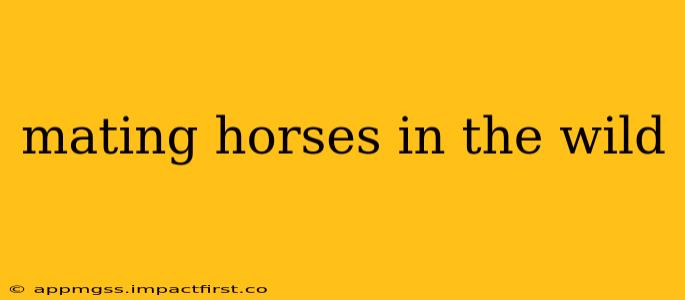Horses, both domestic and wild, are fascinating creatures with complex social behaviors. Understanding their mating rituals, particularly in the wild, provides valuable insight into their evolutionary adaptations and survival strategies. This article delves into the intricate world of wild horse mating, exploring the processes, challenges, and factors influencing their reproductive success.
How Do Wild Horses Choose Their Mates?
Wild horses, or mustangs, live in complex social structures centered around bands, typically led by a stallion. Stallion selection isn't solely based on brute strength; social dominance, genetics, and even perceived health contribute to a mare's choice. A stallion's ability to defend his band from rivals and his overall fitness—indicated by his coat condition, size, and overall vitality—plays a crucial role in his mating success. Mares, exhibiting selective behavior, often assess these factors before accepting a stallion's advances.
What is the Mating Season for Wild Horses?
Wild horses have a distinct breeding season, typically falling between spring and summer. This timing is influenced by environmental factors, including temperature, rainfall, and food availability. The optimal conditions ensure foals are born during a period of ample resources, increasing their chances of survival. The precise timing can vary geographically depending on the climate of the region. The increased daylight hours of spring and summer also trigger hormonal changes in mares, initiating their receptivity to mating.
How Long is a Wild Horse's Gestation Period?
A mare's gestation period, the time from conception to birth, typically lasts approximately 11 months. This lengthy gestation is a common characteristic among equids, allowing for the proper development of the foal. During this time, the pregnant mare requires sufficient nutrition to support both her own needs and those of the developing foal. Access to high-quality grazing is critical for ensuring a healthy pregnancy and a robust foal at birth.
How Do Wild Horses Give Birth?
Wild mares usually give birth alone or in a secluded area within their band's territory. This minimizes risk to both the mare and the newborn foal from potential predators. The birth process itself is relatively quick, and the foal is typically able to stand and nurse within minutes. The strong maternal bond immediately forms, providing the foal with vital protection and nourishment.
Do Wild Horses Mate for Life?
No, wild horses do not typically mate for life. Stallion dominance within a band is often challenged, leading to changes in leadership and mating partners. While a stallion may successfully mate with several mares within his band for a period, his dominance and therefore his access to mares, is not guaranteed long term. The social dynamics of wild horse bands are fluid and constantly shifting, making monogamy unlikely.
What are the Challenges Wild Horses Face in Mating?
Wild horses face several challenges during the mating season. Competition among stallions for access to mares can be fierce, leading to physical confrontations. Predation, particularly of foals, is a constant threat. Environmental factors, such as drought or limited food resources, can also negatively impact reproductive success. These challenges necessitate strategic mating behavior and robust parental care to ensure the continuation of their population.
What are the key differences between wild horse and domestic horse mating?
While the fundamental reproductive biology remains the same, the mating behaviors of wild versus domestic horses differ significantly. Domestic horses often have human intervention in breeding, including controlled mating and artificial insemination. Wild horses rely entirely on natural selection and social hierarchy for mate selection, leading to a more competitive and less controlled mating process. The lack of human management also means that wild horses face more environmental challenges and predation pressure during their reproductive cycles.
This overview provides a comprehensive insight into the fascinating world of wild horse mating. The intricate interplay of social dynamics, environmental factors, and biological processes shapes their reproductive strategies and ensures the continuation of these majestic animals in their natural habitat. Understanding these behaviors is crucial for the successful conservation and management of wild horse populations worldwide.
